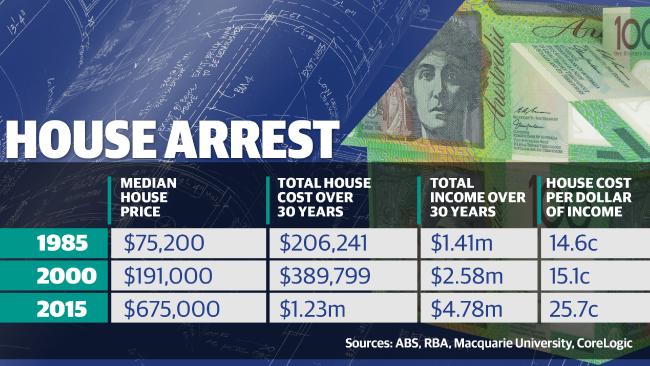First Published: Herald Sun
LET’S deal with a misconception. There’s a refrain among older generations whenever young people lament the high cost of housing.
“Don’t complain,” goes the line. “You’ve got it easy. We had to pay 17 per cent on our home loans”.
Spoken in reference to the late 1980s, it is a statement of fact.
But the implication is that because interest rates were extremely high, homebuyers in that era “did it tougher” than people buying into the housing market now.
This is incorrect.
Certainly, countless Australians with home loans at that time struggled immensely.
At its peak, from mid 1989 to early 1990, the average standard variable mortgage rate across Australia’s major banks was indeed 17 per cent.
Anyone who bought a house in Melbourne two years earlier — at the median price, with a standard mortgage and a typical wage — would abruptly have found themselves parting with more than half their net income purely to cover the interest on their loan.
No doubt many buckled and defaulted as the burden grew impossibly large. And we can’t for a moment dismiss their suffering as trivial.
But with the benefit of hindsight, most homebuyers in that era — relative to people buying their first house now — were exceptionally fortunate.
The numbers lay this bare.
In 1985, Melbourne’s median house price was $75,200.
If you bought then with a 20 per cent deposit and made the minimum repayments on a principal and interest loan over 30 years, your total outlay would have been about $206,000.
This figure takes into account fluctuations in the average standard variable mortgage rate across this period.
Over the same 30-year time frame, if you earnt the average Australian wage, your gross income would have totalled $1.41 million.
Put simply, for every dollar you ultimately earnt, 14.6c would have gone into the purchase of your house.
Using the same formula, if you bought a house at the median price last year, your total outlay — assuming interest rates remain where they are now — will be $1.23 million.
If wages rise over the next 30 years at the pace they have increased over the past 30, you will earn $4.78 million.
For every dollar you earn, 25.7c will ultimately go towards your house purchase.
In relative terms, you will be about $530,000 worse off — money you might have tipped into a small business, invested to support your retirement, or otherwise spent more fruitfully in the wider economy.
This is a recent phenomenon. Applying the same principle to a house bought in 2000, the total outlay would account for 15.1c from each dollar of eventual income. The distortion in prices has happened since then.
Of course, the exercise is rudimentary. It assumes interest rates will now stay constant. They won’t. It assumes wages will keep rising at their historic pace. They won’t.
It doesn’t account for improvements in the quality of housing over time, nor for the discount variable mortgage rates that are now commonplace.
And it doesn’t account for the fact wages in previous generations were taxed at higher marginal rates, while workers now tip a significant part of their pay into superannuation. It doesn’t deal with disposable income.
However crude, though, it paints a stark picture: Our housing, sized up against history, is painfully expensive.
For those who lived through 17 per cent interest rates, the experience was doubtlessly alarming and is understandably seared into their memories.
But it was fleeting. As society tightened its belt and the economy cooled — and eventually slipped into recession — interest rates tumbled. The homebuyers were rescued. The system worked.
Today’s young people can rightly ask if that system is now broken.
They must borrow a far greater multiple of their income to buy into the market or contemplate renting into perpetuity.
And if they do buy and recession then descends, the damage is done.
Interest rates may fall, but the gain for these people will be marginal. Their great expense was in the house price, yet if the housing market collapses, they can’t claw back the principal on their mortgage.
Of course, the trend in house prices over the past 30 years might continue for the next 30: in 2045, we might look back on the today’s homebuyers as the lucky ones.
Likewise, the resources boom that cocooned our economy through the financial crisis might find an unheralded second wind.
And Australia’s record run of 25 years uninterrupted by recession might continue for another 25 years.
But it might not. And it might be that we’ll look back on this as the era when we neglected to keep a critical part of our economy in check — or worse, actively built an epidemic.
Through poor policy, we have warped the market.
We’ve peppered it with homebuyer grants — mostly, thankfully, consigned to history — that stoked demand for housing while doing little to create supply.
We’ve broadly ignored the pleas of developers to overhaul stamp duty and land tax laws, hindering their ability to contain costs.
And we’ve lavished negative gearing concessions on the market — inciting speculation and effectively giving taxpayer handouts to debt-laden landlords, shifting the ledger dramatically in their favour at the expense of would-be owner occupiers.
In doing so, we’ve created an awful predicament: Somebody now has to lose.
Heads says it is the person who is already priced out of the market as the juggernaut rolls on. Tails says it is the person who has jumped aboard just before it shudders to a halt.
Either way, there is a very real risk we’re consigning a generation of young people to untold financial hardship for years to come.
They are right to feel aggrieved.
